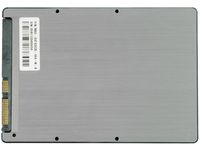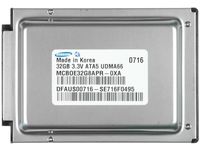14-Way SSD Hard Drive Roundup
Hama Solid State Flash Drives: 3.5” & 1.8”: Big or Small
Most of the flash SSDs on the market were designed for the 2.5” form factor, which makes them suitable for most notebook designs as well as for permanent installation into desktop PCs (the latter only requires some installation brackets). However, there are other form factors available as well, as we could see from aftermarket vendor Hama, whose products are available in central Europe. We looked at its 3.5” desktop drive as well as a 1.8” model that was designed for ultra-portable notebooks, and two different 2.5” drives.
3.5” Hama High-Speed SSD Flash 64 GB
Hama’s 3.5” flash SSD drive is referred to as the High-Speed Solid State Disk Flash Memory Hard Drive, which really is a mouthful. It seems to be difficult to come up with a proper product name that people can remember and that helps to differentiate your products from the competitors. The vendor website adds some more confusion, as it says this device would be ideal for use in mobile devices, which we cannot confirm for a 3.5” device weighing 256 g.
The 3.5” form factor doesn’t register as a negative when it comes to power requirements. This drive requires 0.8 W idle power and reached 1.9 W peak power, which is an average result. This drive isn’t a power miser, though — some flash SSDs such as the models from OCZ or Samsung are far more efficient. But at the same time, there are also others that require more power.
The High-Speed SSD Flash reaches 86 MB/s read throughput and 76 MB/s write bandwidth, and the shortest measurable access time of 0.1 ms. Compared to modern 3.5” hard drives, which reach up to 120 MB/s, this doesn’t seem to be all that much in terms of transfer rate. However, I/O performance was excellent, and the unit scored well in our Workstation I/O efficiency test. The Hama 3.5” High-Speed Flash SSD also achieved nice PCMark05 scores, putting it well in front of every conventional hard drive.
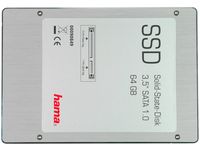
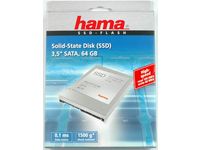
1.8” Hama SSD IDE 32 GB
The second of the four Hama drives we received is a tiny model based on a 1.8” form factor. Unlike all the other models, this drive utilizes an UltraATA/66 interface — that may limit the bandwidth to 50 MB/s on the interface and for sequential reads, but the drive still does relatively well. Write performance is limited to less than 30 MB/s, but keep the form factor in mind. It would probably outperform any 1.8” mechanical hard drive.
We could not run this drive through our efficiency suite on the Dell Latitude D630 notebook, because that machine requires Serial ATA drives. Hence, you will not find the drive in the second set of the test results where we look at efficiency — and power requirements when playing a DVD stream. However, nothing could stop us from measuring idle and peak power. Idle power was exceptionally low at only 0.03 W, while peak power reached 0.8 W. This is about as much as the 2.5” flash SSDs from OCZ and Samsung require, but those are larger and more expensive.
Hama’s 1.8” offering could serve as a replacement for mechanical hard drives, as it delivers better I/O performance, low idle power, and robustness that traditional 1.8” drives cannot give you in the portable space. It beats most of the other Flash SSDs if you are interested in a maximum of number streaming read operations per watt and if you can live with the given performance envelope.
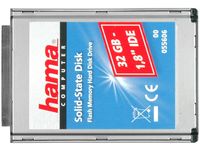

Current page: Hama Solid State Flash Drives: 3.5” & 1.8”: Big or Small
Prev Page Crucial 32 GB Solid State Drive 2.5”: Reads Fast Next Page Hama Solid State Flash Drives: 2.5” SLC & MLC 32 GBGet Tom's Hardware's best news and in-depth reviews, straight to your inbox.

